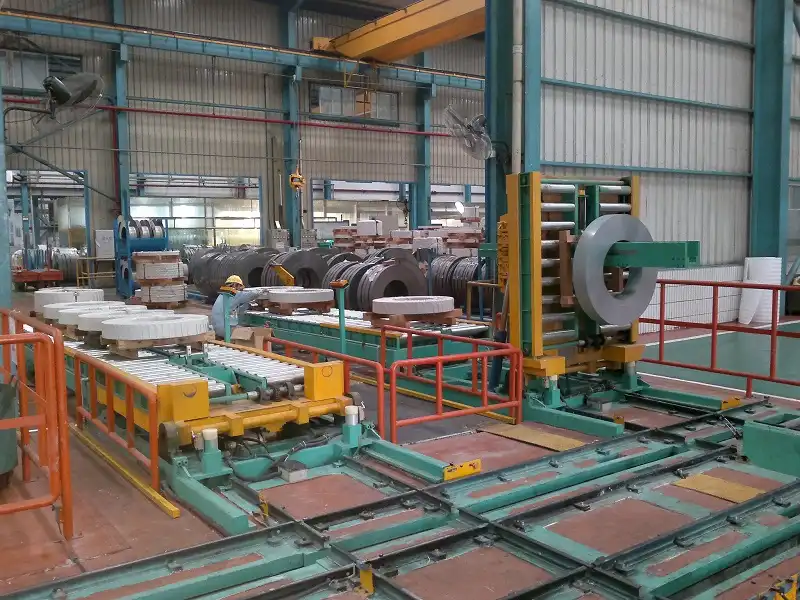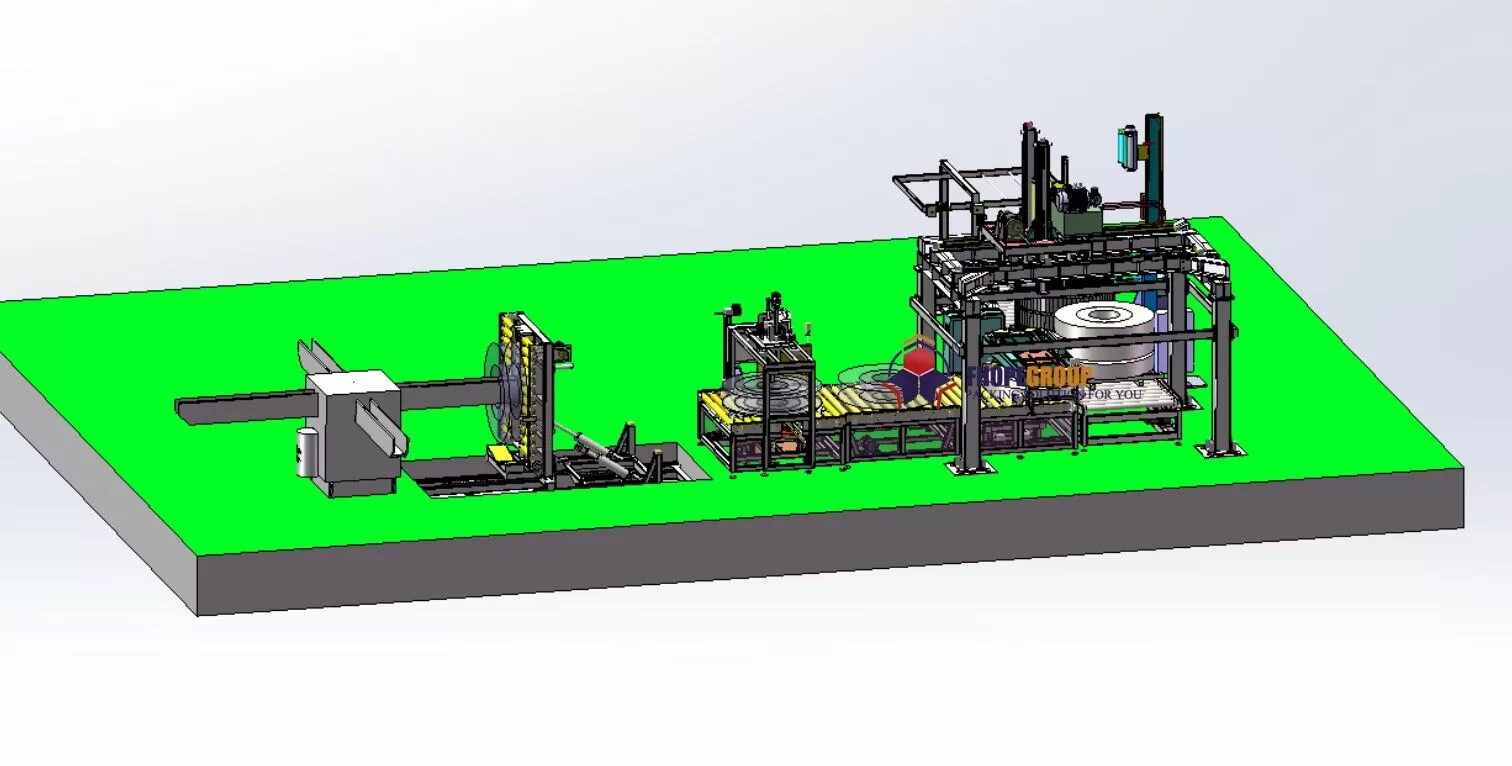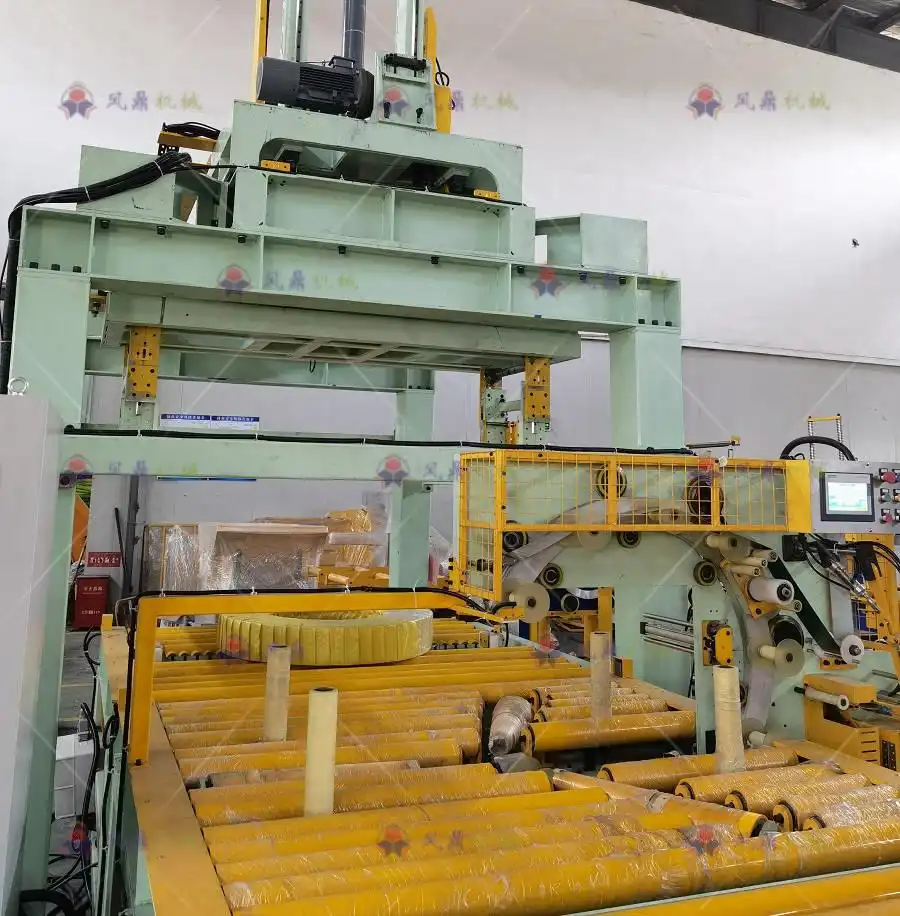Investing in a new steel coil packing line is a major decision. You're not just buying a machine; you're making a multi-year commitment that impacts your entire production flow, product quality, and bottom line. I've seen factories struggle with lines that become bottlenecks, that damage valuable coils, or that require constant, expensive maintenance. The pressure to choose correctly is immense because a mistake here can set you back for years, impacting your ability to compete and satisfy your customers.
The most important features of a modern steel coil packing line are high levels of automation for consistency and safety, robust data integration for real-time monitoring and MES connectivity, and modular flexibility to handle various coil sizes and future market changes. These elements work together to create a reliable, efficient, and future-proof system, not just an isolated piece of equipment.

I understand the weight of this decision. As an engineer who built my own factory, I've been in your shoes. I've analyzed the spec sheets, debated the ROI, and felt the pressure to get it right. This isn't just about the technical details. It's about securing the future of your operation. That's why I want to share what I've learned, using a recent project in Vietnam as a practical example. Let's break down the features that truly deliver value and help you find a strategic partner, not just a supplier.
How Can a Packing Line Directly Address Fluctuating Energy Costs?
You see the electricity and fuel bills every month. They go up and down, but the trend is always upward. This uncertainty makes it incredibly difficult to manage your production costs and maintain healthy profit margins. Many people think of the packing line as a fixed cost, but what if it could become part of the solution? What if the machine itself was designed to actively reduce one of your biggest operational headaches?
A well-designed packing line addresses energy costs by using high-efficiency motors, smart energy management systems, and optimized mechanical designs. Instead of running all components at full power continuously, the system uses power only when needed, significantly cutting idle energy consumption and reducing the overall cost per packed coil.

Dive Deeper: Beyond the Motor Sticker
When I started as an engineer, "energy efficiency" often just meant using a motor with a good rating. Today, that's just the starting point. For a CEO like you, Javier, who has implemented high-level systems like waste heat recovery, the details at the machine level are where the next 10% of savings are found. You need to look deeper into the design philosophy of the entire line.
First, let's talk about "on-demand" energy usage. An old packing line is like leaving all the lights on in your house. The main conveyor, the wrapper, the strapper—they all run continuously, burning power even when a coil isn't present. A modern line operates differently. It uses a series of sensors linked to a central PLC. The conveyor only moves when a coil approaches. The wrapping motor only spins during the wrapping cycle. The hydraulic power pack for the strapper only builds pressure seconds before it's needed. These small pauses add up to massive savings over thousands of operating hours. It directly addresses your goal of lowering unit energy consumption.
Second is the choice of technology. We should compare hydraulic versus electric systems.
| Feature | Hydraulic System (Traditional) | All-Electric System (Modern) |
|---|---|---|
| Energy Use | Pump runs often to maintain pressure, high idle consumption. | Motors use power only during movement. Very low idle consumption. |
| Maintenance | Risk of oil leaks, filter changes, hose replacements. | Fewer moving parts, cleaner operation, less routine maintenance. |
| Precision | Good, but can have slight variations due to fluid dynamics. | Extremely precise and repeatable control over speed and position. |
| Noise Level | Higher due to the hydraulic pump. | Significantly quieter. |
For many functions on a packing line, moving to all-electric servo motors is a huge step forward. They are more than 30% more energy-efficient than their hydraulic counterparts for the same task. For you, this means lower electricity bills and a cleaner, safer, and quieter factory floor. It also reduces the risk of hydraulic oil contaminating your finished products, which is a major quality concern.
Finally, think about regenerative braking. In a system with a large vertical lifter or a turntable that rotates heavy coils, we can implement motors that act as generators when they slow down. Instead of wasting that kinetic energy as heat, it's captured and fed back into the system or the local grid. It's the same principle used in electric vehicles, and it can make a real difference when you're handling coils that weigh several tons, multiple times per hour. These are the kinds of innovations that separate a basic machine from a strategic asset in your factory.
What Does 'Predictive Maintenance' Actually Mean for an Aging Steel Mill?
Your equipment has served you well, but with machines over 15 years old, you know the reality. Breakdowns become more frequent and less predictable. A failure on the packing line can bring your entire slitting or rolling line to a halt, creating a costly bottleneck that ripples through your whole operation. You're stuck in a reactive cycle: a machine fails, you scramble to fix it, and you lose valuable production time.
Predictive maintenance, enabled by IoT sensors and data analysis, transforms this process. It means your packing line actively tells you when it needs attention before it breaks down. By monitoring vibrations, temperatures, and power usage, the system can identify patterns that signal a future failure, allowing you to schedule maintenance during planned downtime and achieve your goal of 95% equipment uptime.

Dive Deeper: From Reactive to Proactive
For a practical leader like you, "predictive maintenance" might sound like another buzzword. Let's make it concrete. I remember a client who had a critical bearing fail on their main wrapping ring. The line went down for two days while they sourced the part and performed the emergency repair. It cost them tens of thousands in lost production. This is the exact scenario we want to eliminate.
Here’s how a predictive system would prevent that. We would install a small, inexpensive vibration sensor on the bearing housing of that wrapping ring motor.
- Establish a Baseline: When the line is first commissioned, the system records the normal vibration signature of that bearing. It learns what "healthy" looks like. This data is stored.
- Continuous Monitoring: As the line operates, the sensor continuously streams vibration data to the PLC or an edge computing device. We're talking thousands of data points per minute.
- Pattern Recognition: The software isn't just looking for a big spike in vibration. It's looking for subtle, long-term changes. For example, a specific frequency might start to increase in amplitude over several weeks. This is an early indicator that the bearing's internal race is starting to wear down.
- Automated Alerts: When the data deviates from the healthy baseline by a pre-set amount, the system automatically triggers an alert. It doesn't just say "Problem with Motor 5." It says, "Vibration signature on wrapping ring bearing indicates 85% probability of failure within the next 150 operating hours. Recommended action: schedule replacement at next planned stop."
This level of insight is transformative. You can order the bearing ahead of time. You can schedule the 30-minute replacement job during a scheduled coil change or a shift change. You avoid catastrophic failure, you avoid unplanned downtime, and you turn your maintenance team into a proactive force rather than a fire department. This directly contributes to your goal of increasing effective run time to 95%. When you multiply this concept across all critical components—motors, gearboxes, hydraulic pumps, pneumatic valves—the packing line stops being a liability and starts becoming a reliable, predictable asset. It's a key part of the digital transformation you're aiming for.
How Does Data Integration Drive Real-Time Business Decisions?
You can't manage what you can't measure. In a modern steel mill, data is as valuable as the steel you produce. You're already planning to deploy an MES and other platforms to get a full view of your operations. But if your packing line is an "information island," you're missing the final, crucial piece of the puzzle. Without data from the end of the line, you don't know the true production count, the exact time each coil was finished, or the specific packaging materials used.
True data integration means the packing line communicates seamlessly with your factory's Manufacturing Execution System (MES) or ERP. It automatically transmits vital data like coil ID, weight, packaging time, and material consumption. This gives you a live, accurate, and complete picture of your production, enabling better inventory management, precise cost allocation, and faster, more informed decision-making.

Dive Deeper: Connecting the Last Link in the Chain
When I visit steel mills, I often see a clipboard and a pen next to the packing station. A worker manually writes down the coil number and time. This manual data entry is slow, prone to errors, and the information isn't available to managers until hours or even days later. This is a huge obstacle to achieving the comprehensive production visualization you want.
A properly integrated packing line solves this. Let's walk through the data flow for a single coil.
- Receiving the Coil ID: As the coil arrives from the slitting line, a barcode scanner or an overhead crane's RFID reader automatically identifies it. This ID is sent to the packing line's PLC. The PLC now knows it is processing Coil #XYZ123.
- Executing the "Recipe": The PLC sends a request to your MES: "What packaging is required for Coil #XYZ123?" Your MES, which holds the customer's order details, responds instantly with the "recipe." For example: "Use VCI paper, three circumferential straps, and four radial straps." The packing line then executes these steps automatically, eliminating operator error.
- Recording Consumption: During the process, the line tracks everything. It knows it used 35 meters of VCI paper and 7 steel straps. It knows the wrapping cycle took 90 seconds and the strapping took 45 seconds. The integrated scale records the final packed weight.
- Transmitting the Final Data: Once the coil is finished and exits the line, the PLC bundles all this information into a single data packet and sends it back to the MES. Your system is instantly updated.
Now, think about the power this gives you. Your sales team can look at the MES and tell a customer with 100% certainty that their coil is packed and ready to ship. Your finance team has precise data on packaging material consumption for accurate job costing. Your production manager can see the real-time throughput of the packing line and identify potential bottlenecks. This data is the foundation for the big-data analysis you plan to implement. You can analyze trends over months to optimize packaging recipes, reduce material waste, and improve cycle times. This is how a packing line becomes an active participant in your digital transformation, helping you hit that goal of reducing overall operational costs.
What Separates a Standard Supplier from a True Strategic Partner?
When you make a significant investment, you are buying more than just a piece of steel. You can get a machine from dozens of suppliers. They will all show you brochures and promise good performance. But as an owner who has built a business from the ground up, you know that the real challenges often begin after the installation is complete. A standard supplier sells you a machine and disappears, only answering the phone when something breaks.
A true strategic partner works with you throughout the entire lifecycle of the equipment. They act as an extension of your own engineering team. This means providing in-depth consultation during the selection phase, offering hands-on support during installation and commissioning, and delivering ongoing advice on optimization, maintenance, and future upgrades. They share their expertise to help you solve problems, not just sell you a product.

Dive Deeper: The Relationship Beyond the Transaction
I built my company, SHJLPACK, on this very principle. I started as an engineer on the factory floor. I know the frustration of dealing with a supplier who doesn't understand your operational reality. When I founded my own factory, I promised myself I would be the kind of partner I always wished I had.
This partnership philosophy shows up in three key areas:
1. Pre-Sale Consultation:
A supplier asks, "What machine do you want?" A partner asks, "What problem are you trying to solve?" When we started the Vietnam project, they initially asked for a specific machine model. But we spent the first two meetings discussing their entire process, from the slitter to the warehouse. We talked about their coil sizes, their downstream customers' requirements, and their five-year growth plan. This led us to propose a more flexible, modular design they hadn't considered, which could easily be expanded later. A partner invests time upfront to ensure the solution is right for your business strategy, not just your technical specs.
2. Installation and Training:
Installation shouldn't be about just bolting the machine to the floor. A partner manages the project collaboratively. We provide detailed layouts and utility requirements far in advance so your site preparation is smooth. During commissioning, our engineers don't just get the machine running. They work side-by-side with your operators and maintenance staff. We don't leave until your team is confident and capable of running and maintaining the line themselves. This hands-on knowledge transfer is critical. It empowers your team and reduces your dependence on outside help for routine issues.
3. Long-Term Support and Optimization:
This is where the difference is most clear. A partner stays engaged. Six months after installation, we should be calling you to ask about performance and review the data. We can analyze the reports from your predictive maintenance system and offer suggestions. For instance, "We see your cycle time on smaller coils is higher than expected. Let's try adjusting the turntable speed parameter to save 5 seconds per coil." A partner also keeps you informed about new technologies and environmental regulations, providing professional advice on how to adapt. This proactive relationship helps you continuously improve and ensures your investment delivers value for many years. It's how we help clients like you succeed, which is the core of our mission at SHJLPACK.
My Insights: The One Thing I Wish I Knew When I Started My Factory
Javier, you and I have similar journeys. We both started on the technical side and built successful companies. We understand the responsibility that comes with being the owner. We know that every decision, especially a large capital investment, rests on our shoulders. When I was building my own packing machine factory, I was obsessed with the technical details: the motor speeds, the steel thickness, the PLC brands. I believed that building the 'perfect' machine was the key to success.
I was wrong.
The most important thing I learned, and what I wish I understood from day one, is this: The machine is only half the solution. The other half—the more important half—is a deep, honest understanding of the client's entire business. The true "Total Solution" isn't just about wrapping steel; it's about solving the client's business challenges. It’s about helping them reduce costs, satisfy their own customers, and grow their company.
I learned this from a client early in my career. He bought a machine from me, and a year later, he told me he was losing business because his packaging looked inconsistent. My machine was working perfectly to spec, but his customers perceived the slight variations in wrap tightness as low quality. I flew to his site. I spent two days not in his engineering office, but with his sales team and in his shipping bay. I listened to their problems. I realized my "perfectly engineered" machine wasn't solving his real business problem. We ended up retrofitting the machine with a new tension control system. It wasn't a major technical change, but it solved his business problem. He not only kept his customers, but he also won new ones.
That experience changed me. It's why our mission at SHJLPACK is about knowledge sharing. It's why I see you not just as a potential customer, but as a peer. Your challenges with energy costs, aging equipment, and market pressure are business challenges, not just technical ones. The right packing line must address these head-on. It must be a tool that helps you execute your strategy. My goal is to share the knowledge I gained through my own trials and successes to help you find that tool and, more importantly, to build the kind of partnership that strengthens your entire operation for years to come.
Conclusion
Choosing the right packing line means focusing on automation, data integration, and a true supplier partnership. These features deliver long-term value far beyond the initial machine price.




